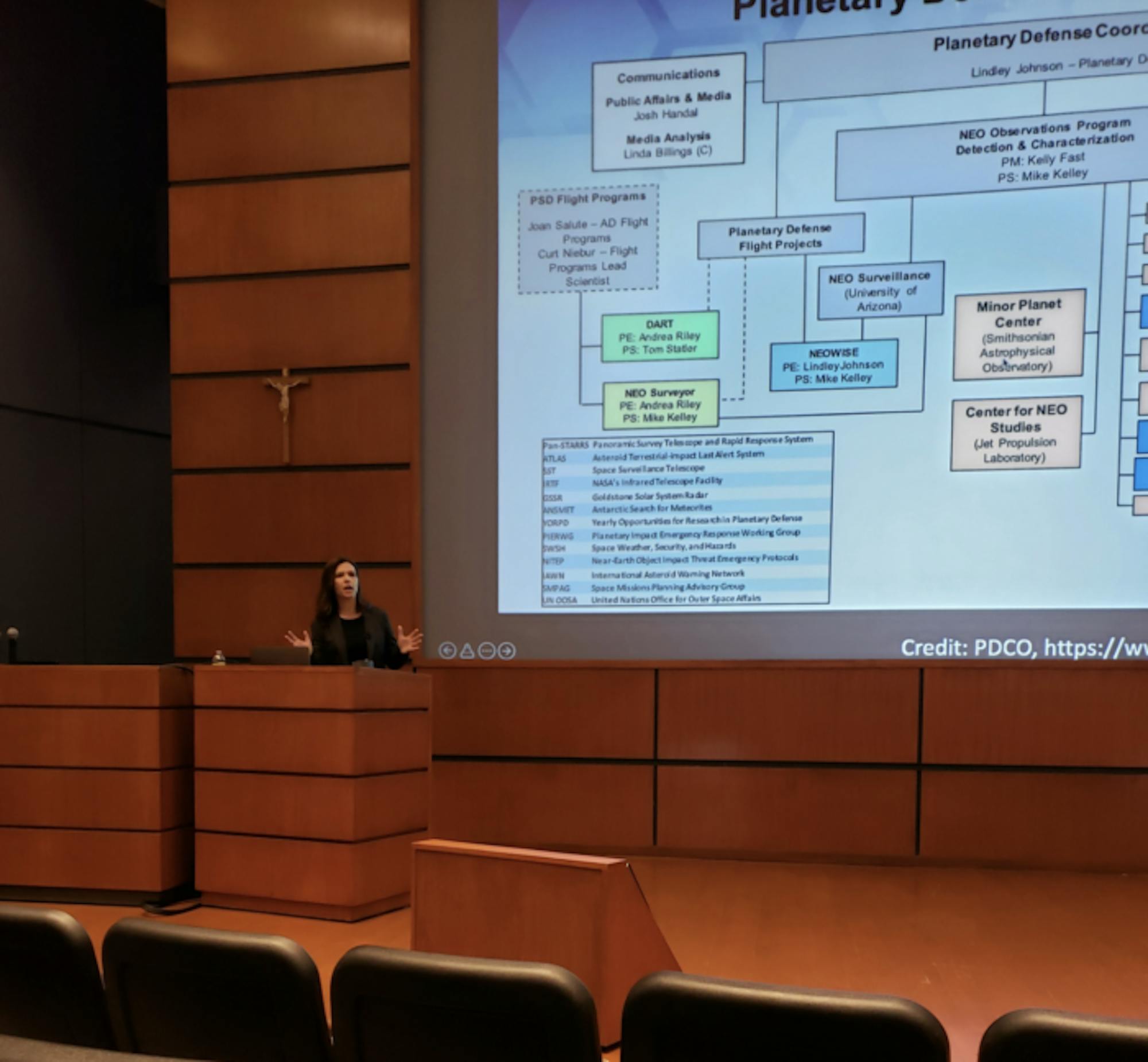In the sixth installment of this year’s ‘Ten Years Hence’ lecture series, the Mendoza College of Business welcomed NASA physicist Marina Brozović Friday morning to speak on the risks asteroids pose to human beings and the opportunities these spinning space rocks may supply our species.
Born and raised in Split, Croatia, Brozović earned her doctoral degree in physics from Duke University and now conducts research in the Jet Propulsion Laboratory at the California Institute of Technology as a radar scientist and orbital dynamicist.
Brozović’s accomplishments include the observation of hundreds of near-Earth asteroids at the Goldstone Deep Space Communications Complex, involvement in the discovery of 14 moons of Jupiter and having the asteroid, 7295 Brozović, bestowed with her namesake.
Though life on the globe has feuded with the worry of the grave ramifications that would transpire if a large meteorite were to strike the Earth ever since the impact of such an object caused the mass extinction of dinosaurs around 65 million years ago, the event that reasserted worldwide awareness of this fret was the collision of the Comet Shoemaker-Levy 9 with Jupiter in July 1994.
Brozović detailed the dramatic occurrence, beheld by amateur and expert astronomers alike across the globe.
“The plumes in the atmosphere were thousands of kilometers high, and the temperature of the impact spot reached 50,000 to 70,000 Kelvins,” she said.
The mile-wide comet sliced dark scars into the surface of Jupiter that were more easily visible than the Great Red Spot for many months.
“If something a mile wide were to impact Earth, this would be a really bad day,” Brozović said. “So much dust would be kicked up in the atmosphere, significantly reducing the sunlight which would affect plant life and then a trigger chain reaction affecting humans.”
Commenting on the fragility of civilization, Brozović estimated that a meteorite of substantial size would have the power to send humanity back to the Middle Ages or worse.
Following this cosmological smash up on the surface of Jupiter, Brozović explained that, in 1994, Congress tasked NASA with discovering, categorizing and cataloging near-Earth objects.
“Our knowledge about the number of objects grew in the past 30 years because NASA started to invest significantly into the discovery of asteroids,” Brozović said. “In 30 years, we’ve gone from having discovered less than ten thousand objects in the main belt to, now, we have identified more than one million.”
Brozović explained that 8% of near-Earth asteroids are potentially hazardous.
“But that is kind of a loaded term,” she said. “Potentially hazardous just means that something is large enough and may potentially come close enough to Earth that we need to pay attention.”
Brozović said the good news is that, so far, we have not found anything that we should worry about, but we also know that many more objects need to be discovered, so it is a good idea to keep vigilance.
She concluded her lecture with a brief discussion of how private organizations and governmental agencies may expand opportunities relating to asteroids. This discussion primarily revolved around Brozović’s evaluation of the feasibility of mining asteroids for water or metal ore in the foreseeable future.
“My personal opinion is that it is not happening in the next 10 years,” Brozović said. “If we are to have profitable mining of asteroids one day, we need to develop a lot more technology.”
She highlighted recent successes in retrieving asteroid samples achieved in missions directed by both NASA and JAXA, the Japanese Aerospace Exploration Agency.
“All these missions are very expensive; they take a long time to complete. The sample return takes six to seven years just from the moment you launch,” Brozović said. “So far, the largest sample we have is 60 grams, which is equivalent to a third of a cup of sugar.”
In recent years, the growth of privately funded aerospace manufacturing companies such as SpaceX and Blue Origin has significantly facilitated the advancement of space exploration.
“Every major player in town has a new rocket coming up; all of them are much more powerful and able to launch more frequently,” Brozović said. “The price of launches is expected to go down because all of these rockets are either partially or fully reusable.”
Even so, the days are more than 10 years hence when human beings will be able to actually mine asteroids.
“We have learned how to do asteroid fly-bys, learned how to orbit an asteroid, how to do soft landings, how to take a sample and how even to bring samples back to earth, but we’re not quite there yet,” Brozović said.













